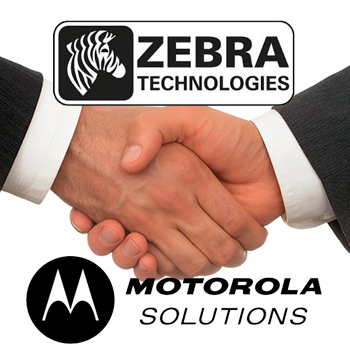Behind the Zebra - Motorola acquisition

Zebra gains instant access to complimentary technologies. But first, it needs to integrate a former partner that is 2-1/2 times its size.
You wouldn’t call it David acquires Goliath, because in the Biblical story, the little guy slays the big guy. Meanwhile, the acquisition of Motorola Solutions ($2.5 billion in revenue/4,500 employees) by Zebra Technologies ($1 billion in revenue/2,000 employees) is a friendly deal all the way around. The deal was the result of a competitive process put in motion by Motorola Solutions last year. Credit a tough economy and favorable lending rates for making it possible. “We were pleased we were able to walk away with these assets,” says Phil Gerskovich, Zebra’s senior vice president of new growth platforms.“In different economic times, we wouldn’t have been able to do this deal, but with low interest rates, it made sense.”
Still, it is anything but an acquisition of equals, and Zebra will have its hands full integrating a company that is 2-1/2 times its size.
That’s one of the most important takeaways from the announcement the other day that Zebra Technologies plans to acquire Motorola Solution’s enterprise business.
The second is that the combined companies have an end-to-end solution for just about any customer’s data collection and mobile computing needs. In the warehouse and distribution space that is important to Modern readers, Zebra is the market leading provider of bar code printers and has strength in passive and active RFID solutions. In terms of verticals, it has real strength in manufacturing and health care. Meanwhile, Motorola Solutions has been the market leader in mobile computing and bar code scanning, with strength in RFID readers, headsets for voice recognition solutions and wireless LAN. As to markets, Motorola is well known in retail and logistics. Together, they not only lead in those categories, but they have a complete portfolio to match the one put together in recent years by Honeywell, especially given its recent purchase of Intermec/Vocollect.
“Zebra gains instant access to several new data capture technology markets,” says Richa Gupta, a senior analyst with VDC Research. “At the same time, they have to integrate 4,500 new employees plus technology that historically hasn’t been their core business. Mobile computing and bar code scanning have fast product cycles, and they will have to learn to keep up.”
The good news, Gupta adds, is that Zebra and Motorola were never competitors. Rather, they have a long history of working together as partners. “This is not market share consolidation in any way,” she says. “That is going their way.”
Zebra Technologies acknowledges the potential pot holes. “Any integration of this size has challenges,” says Phil Gerskovich, Zebra’s senior vice president of new growth platforms. However, he points out that Zebra has tasked Mike Terzich, a long-term Zebra executive who knows Motorola Solutions well, with the integration task. And, he echoes Gupta when he says the two Chicago-based companies have a long history of working together as partners in the data collection space. “We made bar codes and they scanned them,” Gerskovich says. “Our CEOs know each other well, the two companies are culturally- compatible and the fact that we both have corporate headquarters in Chicago helps as well.”
“In terms of our industry, I can’t think of two companies that have been such close friends over the many stages and incarnations of our organizations,” adds Girish Rishi, who oversees global enterprise solutions for Motorola.
In terms of marketing, Gerskovich and Rishi say the Motorola Solutions name will eventually go away, but Zebra Technologies has not determined how Motorola’s products will be branded going forward.
The first is about providing workers on the go with a mobile device, including devices based on smart phone technologies like Android, that’s part of their work flow.
The second is about enabling everyday devices, both at home and in the workplace, with connectivity to the Internet. In the supply chain, that includes adding RFID tags and sensors to assets that can be read and tracked as they travel through the supply chain.
“When we look at these trends, we think there’s a better chance of addressing a complete solution together,” Gerskovich says.
“We are increasing engaging with customers who are no longer simply asking for a scanner or a printer,” adds Rishi. “They want to work with suppliers to cut down their cycle times, process payment transactions on the fly and track their assets. This acquisition is about what is to be and not what is happening today.”
Article Topics
Honeywell News & Resources
Honeywell to drive DC efficiency and enhanced storage capacity via collaboration with Hai Robotics Light-directed systems meet integrated solutions Honeywell demonstrates depalletizer and AS/RS Wireless Mobility: Ready for the next leg up Rapid WMS rollout fits functional needs Real benefits with simulation Automated palletizing pays for itself More HoneywellLatest in Warehouse|DC
Microsoft Unveils New AI Innovations For Warehouses Spotlight Startup: Cart.com is Reimagining Logistics Walmart and Swisslog Expand Partnership with New Texas Facility Taking Stock of Today’s Robotics Market and What the Future Holds U.S. Manufacturing Gains Momentum After Another Strong Month Biden Gives Samsung $6.4 Billion For Texas Semiconductor Plants Walmart Unleashes Autonomous Lift Trucks at Four High-Tech DCs More Warehouse|DCAbout the Author











